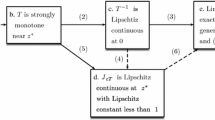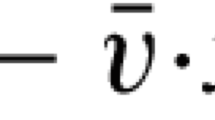Abstract
The proximal point algorithm (PPA) is a fundamental method in optimization and it has been well studied in the literature. Recently a generalized version of the PPA with a step size in (0, 2) has been proposed. Inheriting all important theoretical properties of the original PPA, the generalized PPA has some numerical advantages that have been well verified in the literature by various applications. A common sense is that larger step sizes are preferred whenever the convergence can be theoretically ensured; thus it is interesting to know whether or not the step size of the generalized PPA can be as large as 2. We give a negative answer to this question. Some counterexamples are constructed to illustrate the divergence of the generalized PPA with step size 2 in both generic and specific settings, including the generalized versions of the very popular augmented Lagrangian method and the alternating direction method of multipliers. A by-product of our analysis is the failure of convergence of the Peaceman–Rachford splitting method and a generalized version of the forward–backward splitting method with step size 1.5.
Similar content being viewed by others
References
Bai, Z.Z., Hadjidimos, A.: Optimization of extrapolated Cayley transform with non-Hermitian positive definite matrix. Linear Algebra Appl. 463, 322–339 (2014)
Bauschke, H.H., Combettes, P.L.: Convex Analysis and Monotone Operator Theory in Hilbert Spaces. Springer, New York (2011)
Bertsekas, D.P.: Constrained Optimization and Lagrange Multiplier Methods. Academic Press, New York (1982)
Cayley, A.: On the theory of linear transformations. Camb. J. Math. 4, 1–16 (1845)
Chen, G.H.-G., Rockafellar, R.T.: Convergence rate in forward–backward splitting. SIAM J. Optim. 7, 1–25 (1997)
Combetters, P.L., Wajs, V.R.: Signal recovery by proximal forward–backward splitting. Multiscale Model. Simul. 4, 1168–1200 (2006)
Corman, E., Yuan, X.M.: A generalized proximal point algorithm and its convergence rate. SIAM J. Optim. 24, 1614–1638 (2014)
Davis, D., Yin, W.: Convergence rate analysis of several splitting schemes. http://arxiv.org/pdf/1406.4834.pdf
Douglas, J., Rachford, H.H.: On the numerical solution of the heat conduction problem in 2 and 3 space variables. Trans. Am. Math. Soc. 82, 421–439 (1956)
Eckstein, J.: Splitting methods for monotone operators with applications to parallel optimization. Ph.D. Dissertation, MIT, Cambridge (1989)
Eckstein, J.: Parallel alternating direction multiplier decomposition of convex programs. J. Optim. Theory Appl. 80, 39–62 (1994)
Eckstein, J., Bertsekas, D.P.: On the Douglas–Rachford splitting method and the proximal points algorithm for maximal monotone operators. Math. Program. 55, 293–318 (1992)
Fang, E.X., Liu, H., He, B.S., Yuan, X.M.: The generalized alternating direction method of multipliers: new theoretical insights and applications. Math. Prog. Comput. 7, 149–187 (2015)
Gabay, D.: Applications of the method of multipliers to variational inequalities. In: Fortin, M., Glowinski, R. (eds.) Augmented Lagrange Methods: Applications to the Solution of Boundary-valued Problems, pp. 299–331. North Holland, Amsterdam (1983)
Glowinski, R., Kärkkäinen, T., Majava, K.: On the convergence of operator-splitting methods. In: Kuznetsov, Y., Neittanmaki, P., Pironneau, O. (eds.) Numerical Methods for Scienfic Computing, Variational Problems and Applications, pp. 67–79. CIMNE, Barcelona (2003)
Glowinski, R., Marrocco, A.: Approximation par \(\acute{e}\)l\(\acute{e}\)ments finis d’ordre un et r\(\acute{e}\)solution par p\(\acute{e}\)nalisation-dualit\(\acute{e}\) d’une classe de probl\(\grave{e}\)mes non lin\(\acute{e}\)aires. RAIRO R2, 41–76 (1975)
Gol’shtein, E.G., Tret’yakov, N.V.: Modified Lagrangian in convex programming and their generalizations. Math. Progr. Study 10, 86–97 (1979)
Güler, O.: On the convergence of the proximal point algorithm for convex minimization. SIAM J. Optim. 1, 403–419 (1991)
Hestenes, M.R.: Multiplier and gradient methods. J. Optim. Theory Appl. 4, 303–320 (1969)
Korpelevich, G.M.: The extragradient method for finding saddle points and other problems. Ekon. i Mat. Metody 12, 747–756 (1976)
Lions, P.L., Mercier, B.: Splitting algorithms for the sum of two nonlinear operators. SIAM J. Numer. Anal. 16, 964–979 (1979)
Martinet, B.: Regularization d’inequations variationelles par approximations successives. Rev. Fr. d’Inf. et de Rech. Opér. 4, 154–159 (1970)
Moreau, J.J.: Proximité et dualit ’e dans un espace Hilbertien. Bull. Soc. Math. Fr. 93, 273–299 (1965)
Nemirovski, A.: Prox-method with rate of convergence \(O(1/t)\) for variational inequality with Lipschitz continuous monotone operators and smooth convex-concave saddle point problems. SIAM J. Optim. 15, 229–251 (2005)
Passty, G.B.: Ergodic convergence to a zero of the sume of monotone operators in Hilbert space. J. Math. Anal. Appl. 72, 383–390 (1979)
Peaceman, D.H., Rachford, H.H.: The numerical solution of parabolic elliptic differential equations. J. Soc. Ind. Appl. Math. 3, 28–41 (1955)
Polyak, B.T.: Introduction to Optimization. Translations Series in Mathematics and Engineering, Optimization Software. Publications Division, New York (1987)
Powell, M.J.D.: A method for nonlinear constraints in minimization problems. In: Fletcher, R. (ed.) Optimization, pp. 283–298. Academic Press, New York (1969)
Rockafellar, R.T.: Convex Analysis. Princeton University Press, Princeton (1970)
Rockafellar, R.T.: Monotone operators and the proximal point algorithm. SIAM J. Control Optim. 14, 97–116 (1976)
Rockafellar, R.T.: Augmented Lagrangians and applications of the proximal point algorithm in convex programming. Math. Oper. Res. 1, 877–898 (1976)
Shen, L., Pan, S.H.: Linear convergence of the generalized PPA and several splitting methods for the composite inclusion problem. http://arxiv.org/abs/1508.05156v2
Teboulle, M.: Convergence of proximal-like algorithms. SIAM J. Optim. 7, 1069–1083 (1997)
Tao, M., Yuan, X.M.: On the optimal linear convergence rate of a generalized proximal point algorithm. J. Sci. Comput. 74, 826–850 (2018)
Wen, Z., Goldfarb, D., Yin, W.: Alternating direction augmented Lagrangian methods for semidefinite programming. Math. Progr. Comput. 2, 203–230 (2010)
Author information
Authors and Affiliations
Corresponding author
Additional information
Min Tao was supported by the Natural Science Foundation of China: NSFC-11301280 and the sponsorship of Jiangsu overseas research and training program for university prominent young and middle-aged teachers and presidents. Xiaoming Yuan was supported by the General Research Fund from Hong Kong Research Grants Council: HKBU 12313516.
Rights and permissions
About this article
Cite this article
Tao, M., Yuan, X. The generalized proximal point algorithm with step size 2 is not necessarily convergent. Comput Optim Appl 70, 827–839 (2018). https://doi.org/10.1007/s10589-018-9992-3
Received:
Published:
Issue Date:
DOI: https://doi.org/10.1007/s10589-018-9992-3
Keywords
- Proximal point algorithm
- Step size
- Convergence
- Augmented Lagrangian method
- Alternating direction method of multipliers
- Peaceman–Rachford splitting method
- Forward–backward splitting method




